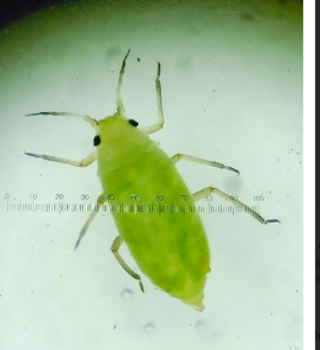Oat and corn aphids
Oat aphids are the most abundant species of cereal aphids and vary from mottled yellow-green through olive-green and dusky brown, to a blackish green, and are characterised by a reddish patch on the tip of the abdomen. Whereas corn aphids are dark blue-green to grey-green.
What is the yield loss from direct feeding damage from aphids?
Aphid feeding can cause direct damage, in the absence of the plant virus; barley yellow dwarf virus (BYDV), by reducing yields by up to 10% and by reducing seed size.
Damaging populations may develop in potentially high-yielding crops (2.5 tonnes per hectare (t/ha) or more).
Direct feeding damage occurs when colonies of aphids develop on stems, leaves and heads, from the seedling stage through to head filling.
The degree of damage depends particularly on the percentage of tillers infested, the number of aphids per tiller and the duration of the infestation.
What are the crop symptoms?
There may be no obvious symptoms while aphids are feeding and causing direct damage. Heavily infested plants may turn yellow and may be covered in a sugary honeydew produced by the aphids and on which black sooty moulds may develop.
Much larger yield and quality losses can be sustained when crops are also infected with yellow dwarf virus. Refer to 'See also' section for further information on this virus.
When and how to monitor for aphids?
For decisions on whether or not to spray insecticides to prevent aphid feeding damage, crops should be checked from late tillering onwards for oat aphids on stems, undersides of leaves and ears and for corn aphids in the furled growing tips.
Walk through the crop in a 'W' pattern, noting the numbers of aphids per tiller at every few paces
What is the threshold?
Spraying with an approved insecticide is worthwhile if 50% of cereal tillers have 15 or more aphids.
Crops sprayed before Zadok's growth stage 30 (start of stem elongation) should be checked again 3-4 weeks after spraying as aphids may re-establish and build up again to threshold levels.
Russian wheat aphid
Overseas, Russian wheat aphid (Diuraphis noxia), is recorded as a major production pest of wheat, barley. Russian wheat aphid (RWA) was found for the first time in Western Australia in 2020.
The aphid injects toxins into the plant during feeding which retards growth and with heavy infestations, kills the plant. Even a few aphids can cause symptoms to appear as early as seven days after infestation.
Plant symptoms from RWA feeeding damage
- Leaf rolling along margins.
- White and purple longitudinal streaks on leaves.
- Hooked-shaped head growth from awns trapped in curling flag leaf.
- Heads with a bleached appearance.
- Plant symptoms can look like herbicide damage, nutrient deficiencies or virus symptoms.
- A noticeable loss of green colouration across the crop, stunted plant growth and loss of vigour.
When and how to monitor for RWA?
The most at risk time for the crop is from stem elongation to when the flag leaves emerge.
Walk through the crop in a 'W' pattern, noting the numbers of aphids per tiller at every few paces.
Thresholds
Do not spray unless necessary. Research investment by the Grains Research and Development Corporation (GRDC) has found the best metric for predicting yield loss from RWA is to determine the percentage of tillers with RWA. On average, for each percent of tillers with RWA there is 0.28 % yield loss.
This research has led to the development of an action calculator to determine RWA yield loss.
Biological control
Parasitic wasps, ladybirds, lacewing and hoverfly larvae can provide useful biological control of aphid feeding damage at low aphid densities. These have been observed predating on Russian wheat aphid as well.
When aphids are in moderate to high densities, these predators and parasites are usually unable to control an increasing population, although given the right conditions certain fungi may kill a large proportion of the population over a short period of time.
If predators are present use 'soft' insecticides such as pirimicarb that selectively kill aphids and leave predators intact.




